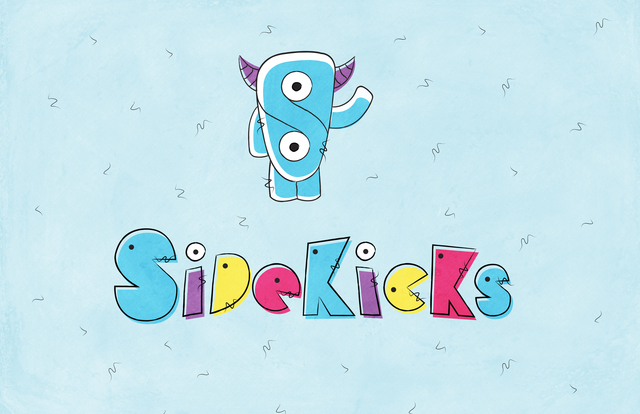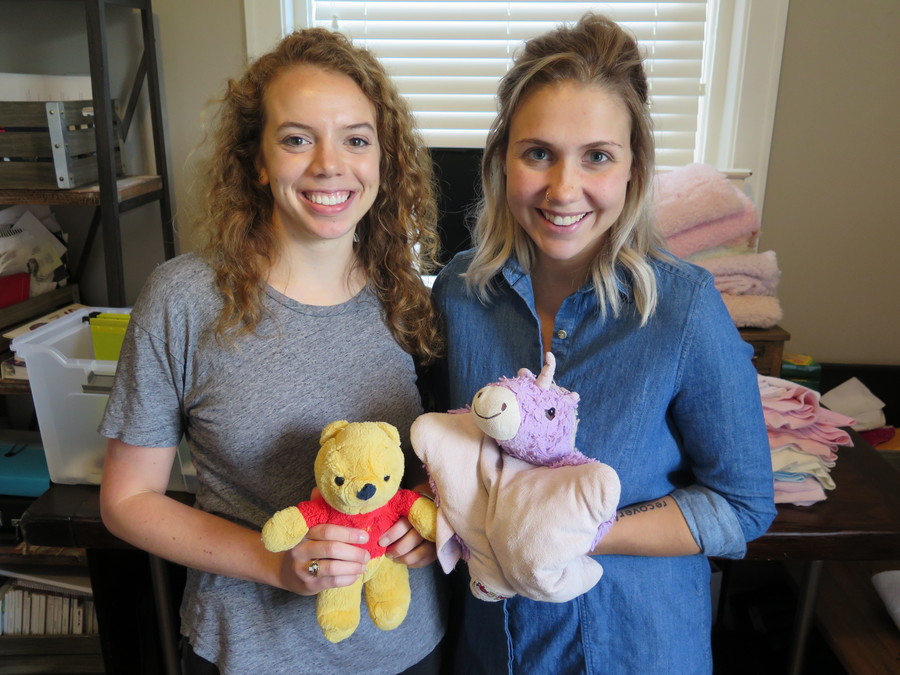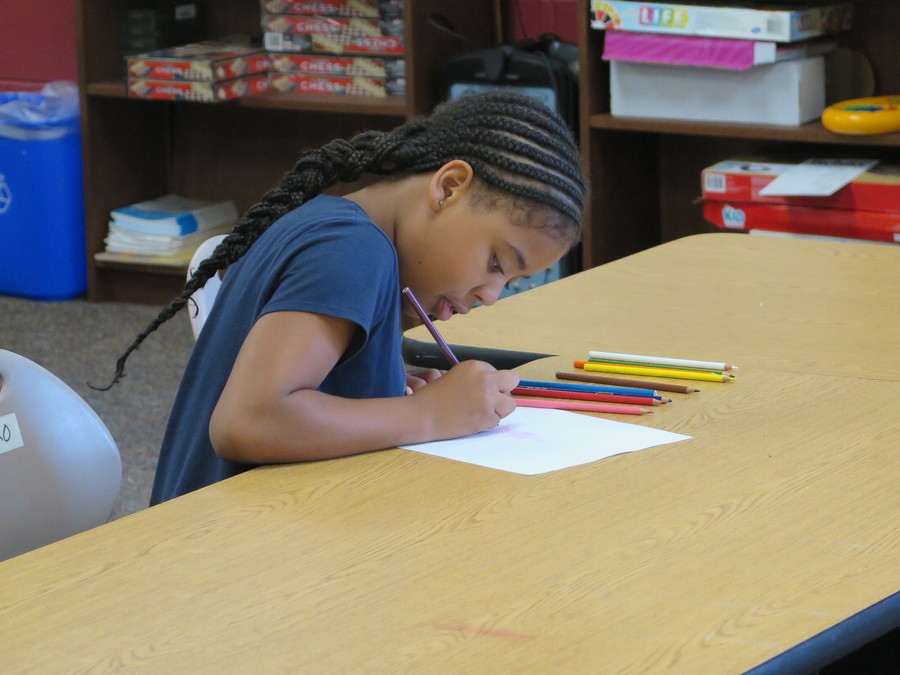CINCINNATI -- Some toys are worth much more than the sum of their stitches and stuffing.

Just ask Jamie Maier and her best friends, the husband and wife team of Andy and Macy Meyer. The three University of Cincinnati undergrads are the creative force behind Sidekicks -- an idea aimed at giving comfort and stability to kids experiencing homelessness in the form of custom-made toys and storybooks.
“It’s a brilliant, brilliant idea,” said James Canfield, an assistant professor at UC’s School of Social Work and an expert on child homelessness. “This gives those homeless kids a chance to have something of their own, something that’s not handed down, something that’s made for them. It gives them a semblance of control. And it gives them a chance to be a kid.”

From left, Andy Meyer, Macy Meyer and Jamie Maier.
The three friends began testing Sidekicks this summer with UpSpring, the nonprofit organization that works to meet the educational needs of children experiencing homelessness or housing insecurity. They worked with kids at UpSpring’s Summer 360 camp.
RELATED: Camp gives homeless kids summer of fun, learning
Maier and Macy Meyer had separate conversations with four different children, asking each child to draw a “new best friend” using crayons or colored pencils. After each drawing was finished, they asked the child questions about it to make sure they understood the details. They allowed each child to see and touch fabric swatches and then pick which fabric would be used for each element of the toy. Then they created custom, one-of-a-kind toys in a studio at their Walnut Hills apartment.

An UpSpring camper named Janiah, left, reveals her Sidekick drawing.
“It’s so important to have no assumptions,” Macy Meyer said.
She learned that when she did a test run with a little boy she knew before the friends started working with UpSpring. When she asked the little boy to draw something, he drew an animal that he said was a bear. When she asked how many legs the bear had, the boy said two. Plus, the bear had a mouth but no teeth.
“I want to keep the integrity of their drawing,” Macy Meyer said. “I don’t want to change it because this is what they’ve envisioned.”

The "bear" prototype with the picture upon which it is based.
Comfort, stability and security
People here who work with homeless kids have been impressed.
“They came to me, and I listened to them, and I was immediately blown away,” said Mike Moroski, UpSpring’s executive director. “What Jamie and Macy are doing is not only unique, it touches upon every best practice for kids experiencing toxic stress.”
Families that become homeless often have moved many times and have lost most of their possessions, said Kevin Finn, CEO of the nonprofit Strategies to End Homelessness. He met with the two young women to discuss their idea, too.
“Frequently that has meant the homeless child has lost everything they have considered their own,” Finn said.
And it happened to nearly 2,000 kids under the age of 18 in Hamilton County last year, according to data from Strategies to End Homelessness.
Having creations -- or Sidekicks -- that are made just for those kids and are based on their own imaginations is powerful.
“When I was a child, I had a blankie,” Moroski said, and he had a piece of it in his pocket when he got married.
“There’s a lot of research that suggests that these items that you have when you’re a child, they actually do have some power over your feelings of comfort and stability.”
The three friends behind Sidekicks knew that even without the research. In fact, their special childhood possessions inspired the whole idea.

Winnie the Pooh and the unicorn Pillow Pet that helped inspire the idea.
Here’s how: Maier and Macy Meyer met with Canfield early on when they were trying to come up with a culminating project for their final year at the School of Design, Architecture, Art and Planning. Macy Meyer is a fashion design major; her husband, Andy, is in graphic design; and Maier studies industrial design.
They all wanted to do something that would help homeless kids but knew they couldn’t solve the problem of homelessness. When Canfield told them that many programs for homeless kids seem to forget that they’re kids, it hit Macy Meyer that she, her husband and Maier each have something from their childhoods that they lean on for comfort and support when times get tough.

Jamie Maier, left, and Macy Meyer with their own sidekicks.
“We have these objects that -- at 20-some-years-old -- we are still attached to in some way, and we find comfort and stability and security in them,” said Macy Meyer, who is 23.
The power of Pooh
The Meyers each have their baby blankets. Plus Macy Meyer has a purple unicorn Pillow Pet that she got attached to after she had surgery as a teenager. For Maier, it’s her well-worn Winnie the Pooh.
“I’ve had Pooh since I was 3 or 4,” said Maier, 22. “He came with me to Japan when I went on study abroad and made it back to the United States.”
The three friends share an apartment in Walnut Hills. And when classes are particularly stressful, even now, they sometimes all sit on the couch holding their blankets and Pooh to relax, Maier said.
The three of them figured it would be great to give that same sense of security to children experiencing homelessness through objects that the children would help create.

An UpSpring camper named Gab picks the fabric for his Sidekick, named "Littel Spity."
They started with the toys this summer, but their idea is even bigger.
They also want to work with kids to help them come up with a story about their sidekicks. The plan is for Maier to write the stories and for Andy Meyer to create the illustrations.
The big vision is for Sidekicks to give each kid a backpack that contains:
- A stuffed toy based on the child’s drawing
- The original drawing
- A one-of-a-kind storybook
- A new box of crayons
- And a small sewing kit for repairs
“We will give them a little tutorial so they don’t feel like they have to just throw it away if it gets damaged,” Macy Meyer said.
The three friends didn’t have enough time to do all that for the first four children at UpSpring’s camp this summer. But they got a good feel for the types of questions to ask the children, how long it would take to create the toys and what technical challenges the kids’ fabric choices could present.

The Sidekicks partners have pages of typed notes from interviews that Jamie Maier has color-coded based on subject matter. The notes are taped to a wall in their home studio.
The storybooks will be part of their next tests of the idea.
“The book is going to be something that encourages them to expand their imagination and think outside of the box that is kind of promoted by their stuffed animal,” Macy Meyer said.
Love your sidekick, love yourself
So far, every local expert who has talked with the friends about their project has loved the concept, they said.
They have gotten so much encouragement, in fact, that Maier and the Meyers have started a GoFundMe campaign in hopes of raising money to grow the idea into a nonprofit organization and travel to conferences to share their research and findings.
“We’re not going to solve this problem, and it would be absurd if we were to propose that,” Maier said.
But Maier and the Meyers have spent hours researching homelessness and how it impacts children. In addition to Canfield, Moroski, Finn and other local experts on homelessness, they interviewed an art therapist about the types of materials the children should use to make their drawings.

An UpSpring camper named Janiah draws her unicorn Sidekick with colored pencils.
The advice was to give them either colored pencils or crayons, which give them some control over their artwork and aren’t too free-flowing, like markers or watercolor paint could be.
Maier and the Meyers also researched the importance of transitional objects such as toys and how they can impact a child’s relationships.
“If you can love the stuffed animal and take care of it, you can love yourself a little bit more and take care of yourself a little bit more,” Maier said.
It’s a warm and fuzzy idea built on a strong foundation of research, organization and planning.
Canfield said he would like to see it take off throughout Greater Cincinnati and across the country.
“They found their niche,” he said. “I really hope that one day this ends up being a national thing.”

All the kids' pictures for Sidekicks and the "bear" prototype.
For now, though, there are four local kids who have one-of-a-kind toys that they designed themselves. That doesn’t solve all their problems, of course. But it showed them that some UC college students cared enough to listen and make something just for them.
Six-year-old Zamari smiled big when he got his 11-legged creature named Kihine, a name that despite its spelling is pronounced “Creech.” He had explained that some of the smiling creature’s legs were longer than others, and some could lift up cars and hold them up high.
“Is he just how you wanted him?” Macy Meyer asked Zamari after the big reveal.
“Yeah,” the little boy said, smiling, before he plopped the toy on his head like a hat. “He looks like Kihine.”
That, of course, was exactly how he was supposed to look.

UpSpring camper Zamari and his Sidekick, Kihine.
More information about Sidekicks and how to contribute to its GoFundMe campaign is available online.
Lucy May writes about the people, places and issues that define our region – to celebrate what makes the Tri-State great and shine a spotlight on issues we need to address. Childhood poverty is an important focus for her and for WCPO. To read more stories about childhood poverty, go to www.wcpo.com/poverty.
To read more stories by Lucy, go to www.wcpo.com/may. To reach her, email lucy.may@wcpo.com. Follow her on Twitter @LucyMayCincy.





